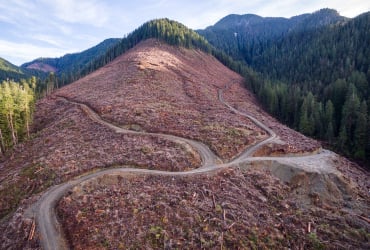I am grateful to live and work in the traditional, ancestral and undisclosed territory of the First Nations xʷməθkʷəy̓əm (Musqueam), Sḵwx̱wú7mesh (Squamish) and səlilwətaɬ (Tsleil-Waututh).
We just passed the first anniversary of the anti-logging protests in Fairy Creek.
Children, parents, seniors, professionals and many people who have never participated in a protest like this are lining up in record numbers to defend a forest in southwest Vancouver Island. Images of protesters and the RCMP in battle have made BC infamous as the protests passed a painful milestone last month, becoming the largest act of civil disobedience in Canadian history, surpassing the Clayoquot Sound protests, which had place almost three decades ago.
Meanwhile, government and industry leaders continue to tout BC as a “world leader in sustainable forest management.“
Fairy Creek Lumber Company Teal-Jones dedicates a page to their website to how it meets “Canada’s leading national standard for sustainable forest management”, having been certified by the Canadian Standards Association (CSA) “sustainable forest management standard.“
This apparent inconsistency is a picture book example of green washing, particularly the creative use of the words “sustainable forestry”. This phrase has its roots in 18th century Germany when it meant “sustained yield” or “sustained felling.” Back then, forests were a crop that had to be harvested and replanted successively.
This is very far from a modern definition of sustainable forestry, as developed in the 1993 Ministerial Conference for the Protection of Forests and adopted by the United Nations. This definition recognizes that forests serve society in essential ways beyond the supply of wood. This includes purifying water and air, moderating flooding, providing food and medicine, and providing habitat for wildlife.
By this definition, “sustainable forestry” means using forests in a way – and at a rate – that maintains their biological diversity, productivity and regenerative capacity to fulfill, now and in the future, ecological, economic and social functions.
Fairy Creek clearly tells us what definition of “sustainable forestry” is actually used in BC
Located at Tree Farm License 46, the Fairy Creek watershed contains highly productive western coastal hemlock forests.
These forests would normally be at least 80 percent old growth (forests over 250 years old) and would have towering century-old trees, a rich understory, and complex habitats unique to ancient ecosystems.
Opinion: Fairy Creek clearly tells us what definition of “sustainable forestry” is actually used in BC, writes @ DevonPage5 of @ecojustice_ca. #FairyCreek #BCpoli #Logging #OldGrowth
At the last count in 2009, only 10 percent of the primary forests remained. By now, the Fairy Creek forests are likely closer to the provincial average of the remaining three percent old growth. This falls well outside the modern definition of sustainable forestry.
But if your business is seeing old growth, pointing out that the logging at Fairy Creek meets Canada’s definition of “certified sustainable” is good for the bottom line. And that is the point.
In the wake of the Clayoquot Sound protests, Canada’s forestry industry needed a serious rebrand. “Certification” was seen as a way to help Canada promote itself as a world leader in sustainable forestry, and CSA was a ready partner.
It worked. After Clayoquot, Canadian governments and the forestry industry went on a glamor offensive and, backed by “certification”, restored Canada’s reputation and markets.
It did not matter that the certification did not contain hard and fast rules that required sustainability. The British Columbia government went one step further, consolidating standard setting and industry self-regulation in its forestry laws. In these laws, the government also moved to expressly limit factors such as wildlife habitat protection that could decrease the rate of logging.
That’s a key reason why the last time government biologists looked, they could only find two spotted owls that depend on old growth in the wild.
It is also the reason why the British Columbia forest industry is in decline. Years of overshoots have led to what the government calls a “drop” – a necessary reduction in the amount that can be recorded annually. Since 2000, 35 sawmills have closed and Forestry jobs in BC have been cut in half.
However, including Fairy Creek, more than 1.6 million hectares of British Columbia forest is planned to be logged to the CSA Sustainable Forest Management Standard.
Forestry in British Columbia will never be sustainable until government and industry stop doing greenwashing.
Earlier this summer, on behalf of six British Columbia citizens representing forestry, industry, tourism, the environment, and indigenous interests, Ecojustice presented a complaint to the Cartels and Deceptive Marketing Practices Branch of the federal Competition Office asking it to investigate the CSA’s false and misleading statements about its forest certification standard.
We hope that, by seeking a large fine, we can dissuade the British Columbia industry and the greenwash government from so-called sustainable logging.
Until then, if someone asks you if BC records sustainably, just point out Fairy Creek.
Devon Page is the CEO of Ecojustice, Canada’s largest environmental law charity. It obtained the first court order in Canada to stop logging in primary forests that are home to the northern spotted owl.
Reference-www.nationalobserver.com
